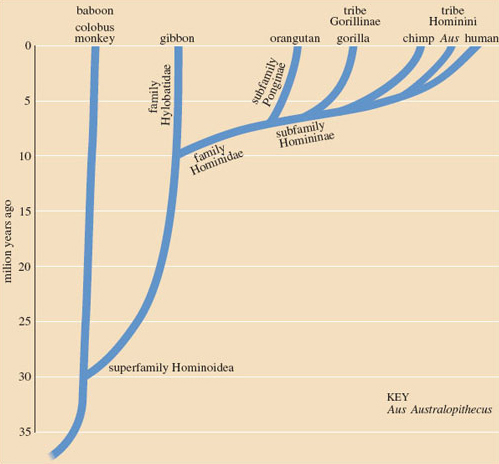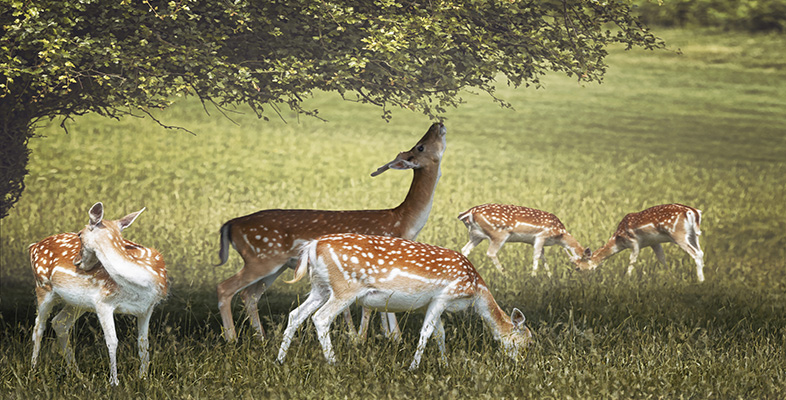1 The apes and their relationship to humans
As you work through this course you will come across boxes, like this one, which give you advice about the study skills that you will be developing as you progress through the course. To avoid breaking up the flow of the text, they will usually appear at the start or end of the sections.
As well as the course text, you will be using The Life of Mammals book (LoM) and related The Life of Mammals DVDs, as described in the introduction to this course. Before you go any further, watch 'Food for Thought' on the DVD and read LoM Chapter 10. Unless stated otherwise, all the page references you encounter in this course will be to LoM.
You were no doubt already familiar with apes before you watched 'Food for thought', because they are so prominent in zoos and have featured in many other TV programmes and films as beautiful and interesting animals. Sadly, apes will also be familiar to you because of the well-publicised risks most of them face of habitat loss and imminent extinction. You will recall from the TV programme and LoM Chapter 10 that there are relatively few species of ape living today. The smallest apes - frequently called the lesser apes - are 11 species of gibbons and siamangs living in the forests of Southeast Asia. The great apes, comprising (according to most experts) seven species, include the orangutan, which lives in Asia, and African species - the chimpanzee, the bonobo, the gorilla (and humans).
As long ago as 1837, Charles Darwin was struck by the close similarities between the great apes and humans, and was convinced of their close evolutionary relationship. He had seen an orangutan, Jenny, at London Zoo, the very first ape to be brought to England. Jenny disturbed those who saw her, because her close resemblance to humans blurred the perception of a sharp distinction between humans and animals. In 19th century Europe, humans were regarded as 'special', set apart from and above animals. The first part of the TV programme provides us with an opportunity to experience a little of what Darwin must have felt when he first saw an orangutan.
Activity 1
Watch the TV programme from 00.33-13.39. The first part is about the rescued orangutans at Camp Leakey in the Tanjung Puting Reserve in central Borneo, and the second covers wild orangutans in northern Sumatra. The final part looks at the behaviour of rescued chimpanzees living in a reserve at the mouth of the Congo River. Jot down notes as you watch, focusing in your note-taking on:
(a) anatomical features of the apes, including relative lengths of arms and legs, anatomy of hands, and facial structure;
(b) aspects of behaviour, including style of locomotion, whether arboreal or terrestrial, and manual dexterity;
(c) learning and social interactions.
Download and print the PDF of Table 1, linked below, then use your notes for (a) and (b) to fill in the columns. Information for humans in the final column is already given for comparison.
Click 'View document' to open Table 1
View document [Tip: hold Ctrl and click a link to open it in a new tab. (Hide tip)]
Discussion
Check your entries with the completed version of Table 1 given below.
| Feature | Orangutan | Chimpanzee | Human |
|---|---|---|---|
| relative length of arms and legs | arms longer than legs | arms longer than legs | legs longer than arms |
| length of fingers | long relative to size of hand | long relative to size of hand | long relative to size of hand |
| position of eyes | forward pointing | forward pointing | forward pointing |
| face flat or forwardly projecting | face forwardly projecting; high forehead | face forwardly projecting | face flat with high forehead |
| body hair | thick and long orange fur | long sparse hair over body | very little body hair |
| arboreal or ground-living | arboreal; wild individuals spend very little time on the ground | arboreal but also spends time on the ground | lives on the ground; never arboreal |
| locomotion | four limbs used for moving through canopy; sometimes brachiation used | four limbs used for moving through canopy; sometimes brachiation used; knuckle walker on ground; sometimes bipedal | bipedal, but can also climb |
| manual dexterity; tool use | very good; makes and uses tools | very good; makes and uses tools | excellent; makes and uses tools |
| childhood | prolonged (around 13 years) | prolonged (around 10-12 years) | prolonged (around 15-18 years) |
As the completed table suggests, there are significant differences between humans and orangutans and chimpanzees, but the similarities you have recorded suggest our close evolutionary relationship to apes. Darwin's publication of The Origin of Species in 1859, in which he so eloquently explained his view of evolution, implied that natural selection applies to human evolution too. He concluded:
When I view all beings not as special creations, but as the lineal descendants of some few beings which lived long before the first bed of the Cambrian system was deposited, they seem to me to become ennobled.
Later, in his book The Descent of Man (published in 1871), Darwin suggested that humans had evolved from an African ape-like ancestor. He thought that the existence of predators and the harsh climatic conditions in Africa had provided the intense selection pressure that resulted in the evolution of a biped from an ape, via the process of natural selection. Darwin did not have much evidence for his view, as little fossil evidence and no molecular evidence was available in the 19th century. Nevertheless, subsequent research has shown that he was right.

You will be aware that classification systems aim to reflect evolutionary relationships and are based on both anatomical and genetic similarities. The classification of apes and humans takes account of the close evolutionary relationship between humans and the chimpanzee, as revealed in Figure 1, above. Look at Figure 2 in S182_8 Life in the trees and notice the links between the two diagrams; for example, both diagrams show the split between the lesser and great apes (Hylobatidae and Hominidae), about 10 million years ago. The split between the Cercopithecidae (i.e. Old World monkeys, of which the baboon and colobus monkey identified on Figure 1 are just two examples) and the superfamily Hominoidea (Figure 1) occurred about 30 million years ago, which corresponds to the same branch point shown in Figure 2 of S182_8 .
Biologists are generally agreed that humans and all types of ape are grouped within the superfamily Hominoidea, as in Figure 1. But there is disagreement about more detailed groupings, so you will probably come across different classification schemes. The classification followed here groups the great apes and humans in the family Hominidae. Apes and humans are subdivided in two subfamilies, Ponginae (orangutans) and Homininae (other great apes and humans). Note that there are extinct Homo species, e.g. Homo erectus, as well as our own species, Homo sapiens, and also an extinct group of ape-like creatures, the australopithecines; these are all grouped together in the tribe Hominini. Homo species and australopithecines are known as hominines; you may recall the term 'humanoid' that author David Attenborough (DA) uses to refer to extinct hominines [p. 296].
The big question implicit in LoM Chapter 10 is, of course, who were our ancestors? In Section 4 and Section 5, I will be looking in more detail at the two ancient species, known only from their fossils - an australopithecine and Homo erectus - briefly mentioned by DA [p. 300]. Such fossil species are considered to be on or close to the evolutionary line leading to Homo sapiens, because their dates are appropriate and they have some of the defining anatomical features of humans, such as adaptations for bipedal walking and a large brain size.
Before we explore the fascinating question of who our ancestors were, I'll be looking more closely at living species of apes, in order to pick up clues about social structure and lifestyle in our ancestors. In Section 2, I'll be building on what you know from watching apes in the TV programme and reading LoM Chapter 10, applying the information to a more detailed study of social structure in the orangutan and the chimpanzee. From LoM and the programme you will already be aware that chimpanzees are expert tool-users - Section 3 looks at a few examples of tool use in detail and shows how tool use is related to culture. Prior to the 1960s, both tool use and culture were fixed in many biologists' and anthropologists' minds as being defining features of Homo species. Now views have changed; our society is far more complex than those of apes, but we should not conclude that only humans have culture. By exploring the social structure of the great apes, we can pick up clues about the lifestyles of our ancestors and gain some understanding about why we humans behave as we do.
